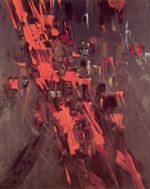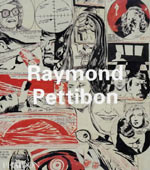Beached
| |

| Walking alone on Porthmeor beach at St Ives last week, for the first time I think since I left Scotland I felt like I missed the sea. Hearing its gentle sighs as the tide came in, seeing the sharply defined late November afternoon shadows cast by the footprints, both human and bird, and by the tiny canyons created by the water falling across the sands; watching the waves swirl around the rocks, making their ever changing patterns of ripples. Thinking about the way the sands looked like the moon, and remembering an old story and an older friend and wondering where they are now, what they are doing now. Realising I'm older and none the wiser. Thinking that it would be nice to live by the sea, if only it could always be solitary. The later (1970's) Bryan Wynter paintings currently showing in the Tate at St Ives recall the patterns of water but I don't like them anywhere near as much as I like watching the sea. The paintings seems to be so sloppily painted, which might be fine if they didn't give the impression that the flatness and precision of the coloured ripples night be important. The colours themselves are pretty uninteresting too, just seemingly casual choices that manage to date the paintings very much in the early '70s: imagine you were filming a period drama in the 1970's, and these are paintings you could choose to hang on the walls to establish the era. And everyone knows the early '70s were horrid and ugly, don't they? Really though, these paintings fail to fizz, or float like, say, the paintings of Wynter's contemporary Patrick Heron do from the same period. Heron's paintings, like 'Big Cobalt Violet' of 1972, manage to both root themselves in time, and to appear timeless, thanks mainly I guess to their rigorous care in the choice of colour and form. Heron's paintings seduce, draw you into illusory depths, like Rothko before him and maybe Gary Hume after (and at this point let me point out that Phaidon's Heron monograph is an absolute gem of a book). By contrast Wynter's paintings seem like lazy hippy doodles, hanging limp like flaccid flags. |

| Better by far, at least for me, are Wynter's paintings from the '60s. It would seem that these paintings are again very much to do with the tunings and turnings of nature, with the layering of marks reflecting on water courses and pathways made by natural forms. Personal context, however, is all, and these painting to me seem much more pertinent to urban spaces, being redolent of moving through city streets, often at night, and if you had to talk in figurative terms, 'Firestreak IV' would be the tail lights of the traffic streaming across Brooklyn Bridge, Manhattan looming below and us floating above the world. And in fact 'Firestreak IV' oddly puts me in mind of Georg Grosz' 'The Funeral', with its wild eyed, controlled anger, but that's probably just because I've been listening to McCarthy again recently, with of course 'The Funeral' gracing their I Am A Wallet debut. There's a thought too that these Wynter paintings could be like paintings recording in some abstract manner the sub-atomic resonances of nature; notes on the invisible dynamics of nature made concrete in paint. And if that were the case, the paintings then seem to be about taking control of those resonances, of establishing an unbreakable hold over nature. And naturally this is just my thoughts, and my personal context at work. Wynter, I am sure, would never have thought such things, being, it seems, a devoted and immersed nature lover. |
Of course part of my consideration of the Wynter paintings has been coloured by the recent reading of Michel Houellebecq's fine Atomised, in which all manner of philosophical avenues are explored and referenced to the science of bio-physics. It's an intriguing and addictive book, filled with thoughts and ideas which I can't help find incredibly seductive and relevant in the current climate of early 21st Century blues. Essentially, what I find seductive is the notion of the triumph of humankind and its bio-technologies over 'nature' and the idea that love and sex are not mutually dependent. Without wanting to sound flippant, I think this is an essentially Pop concept. I think that what Pop culture at its best essentially tells us, is that notions of 'adulthood' and family structure are at best out-dated modes of existence and that by giving up on such ideas we can enter into a world of eternal 'pleasure' (I'm including notions of sadness as being implicit in that word), creativity and of course consumption. Then again, I could be talking complete crap. | |

| Speaking of the current 21st Century Blues, I've been thoroughly enjoying the Phaidon publication on Raymond Pettibon, as part of their excellent ongoing Contemporary Artists series. Older readers might recognise Pettibon as being the artist behind the design of record sleeves by the likes of Black Flag and Minutemen back in the '80s, or if they are really hip for his Tripping Corpse fanzines from the late '70s. Pettibon's work has always had either an implicit or explicit political meaning, and often recalls Situationism in it's purloining of text and image to make new meaning. His work can be seen to be very much rooted in a time and place (1980's America), when Politics were very much on the agenda, and if it faded in perceived meaning and relevance in the de-politicized '90s, it suddenly again seems pertinent and insightful. His powerful, signature drawing style mixes with hand-written text to create what at times feel like disembodied comic book frames, moments caught in the flashbulb, giving glimpses of a story in the making. He also playfully and skilfully makes post-(punk)-modernism palatable with text alone, like in the 1978 'Psychedelic Translation of Allen Ginsberg's Howl', referencing in this his youthful obsession with the language of the Beats, transfigured through the pages of Mad magazine. It's strange stuff. Of course text, in extended and in fractured form, is an intrinsic part of Pettibon's work, and like Hip Hop graffiti 'artists' Raymond Pettibon could, or should, perhaps more rightly be called a 'writer'. And, like graffiti's punctuation of the urban environment as both a unifying, contextualising device and a fracturing reflective canvas, Pettibon's drawings work as artefacts which cast momentary illumination on life, whilst at the same time reinforcing the transitory and illusory nature of it: Looking at Pettibon's drawings is like turning the dial back and forth on the radio, with snatches of text, music, lyrics and static cascading over your brain, and you struggling to piece together some kind of meaning from it all. Quite simply, Pettibon is a fabulous and influential American post-Punk Pop artist, and for anyone with even a passing interest in the US post-punk underground, this book is highly recommended. © Alistair Fitchett 2001 |